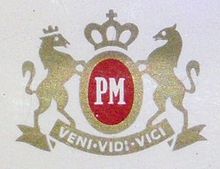Vat 69 - Blended Scotch Whisky - 700 ml
William Sanderson was born in Leith, Scotland January 27, 1839. He started an apprenticeship with wine and spirituous liquors producer Matthew Buchan at the age of 13. By 1863, he already owned his own business producing liqueurs and whisky blends. In 1880, his son William Mark joined the business and persuaded his father to bottle various blends of whisky.
The iconic Vat 69 bottle with its bulbous neck was introduced to the market and was not changed for the next hundred years. In 1882, William Sanderson prepared one hundred casks of blended whisky and hired a panel of experts to taste them.
The batch from the cask (or “vat”) with number 69 was judged to be the best, and this provided the whisky's brand name. The whisky was at first bottled in port bottles. In 1884, Sanderson bought the Glen Garioch distillery which was situated in the middle of a barley field. The distillery was meant to ensure the delivery of grain whisky.
Sanderson took care that there were always new products to be blended, because DCL, which was a strong society at that time, controlled such a large amount of the production that it had a huge influence on the supply of the competing company. For this reason Sanderson, together with Usher and Bell, founded a company to produce grain whisky, which still exists today as the North British Distillery. Sanderson sourced a few malt whiskies used to blend VAT 69 from a friend, John Begg, who owned the Royal Lochnagar distillery. When Begg died, Sanderson became director of Begg's distillery. In 1933, Sanderson's company merged with Booth's Distilleries, which merged again with the DCL-Group in 1935.
In autumn 1980, "Vat 69 Reserve" from the House of Sanderson had its world première in England.
Despite its name, it is not a vatted malt, but a blend of about 40 malt and grain whiskies. Vat 69 Reserve carries no standard age statement because of the combination of the malts and grains.
 |
| Glenesk (silent) - Rare Old - 1980 34 year old Whisky |
Since autumn 1980, Glenesk, which is a 12-year-old Highland Single Malt (40%), is available from Sanderson in Germany. Amazon España. Glenesk is stored for at least 12 years in sherry barrels. Since 1964, William Sanderson & Sons Ltd. has produced "Antiquary", which is a 12-year-old De-Luxe-Scotch-Whisky (40%).
Whisky products available from Sanderson in Germany are:
- VAT 69 Finest Scotch Whisky (40%)
- VAT 69 Reserve de Luxe Scotch Whisky (40%)
- Glenesk Single Malt Highland Scotch 12 Years Old (40%)
- The Antiquary de Luxe Old Scotch Whisky 12 Years Old (40%).
Whisky products available from Sanderson in Australia are:
- 700 mL Vat 69 Fine Scotch Whisky (40%)
VAT 69 was referenced many times in the HBO mini series Band Of Brothers, as the preferred drink of Captain Lewis Nixon
Penny Priddy (played by Ellen Barkin) blames her emotional state on “too much Vat 69” in her first scene in Buckaroo Banzai.
Vat 69 is also referenced in Bartender, a manga by Araki Joh and Kenji Nagatomo.
- "Sanderson's". Master of Malt.
- ^ "Member's Principal Brands". Scotch Whisky Association.
- ^ "William Mark Sanderson". Geni.com.
- ^ "William Sanderson & Son Ltd Distillers, Leith". Leith Local History Society.
- ^ "Sanderson's". Master of Malt.
- ^ "VAT 69 Blended Scotch Whisky". Master of Malt.
- ^ "Vat 69 Blended Scotch Whisky". Bring a Bottle.



